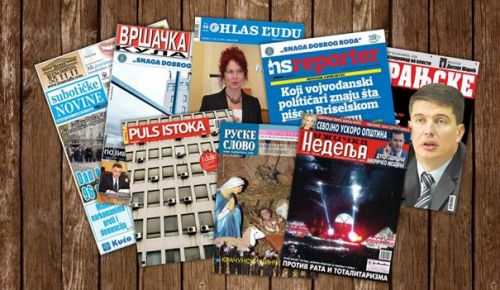Local media in Serbia are facing problems that have threatened their survival for years: inconsistent legislation, non- transparent ownership, unfinished and poorly conducted privatization, political pressure and financial sustainability are just some of the obstacles. The floods that afflicted Serbia in May 2014 endangered many lives and caused great economic damage. In these circumstances, the importance of local media was clear: they were the fastest in reporting about water levels, hazards of flooding, evacuation of the population and collection of humanitarian aid. For citizens, the state of emergency lasted one week – in local media it has been going on for years and there is no indication that the red light will turn off in the near future.
Victims of Privatization
We can learn a lot about the chaos that was present in the Serbian media scene in the period from 1990 to 2002 from the fact that two new radio stations on average were launched every week and the majority of them were not licensed.1 After the democratic changes in Serbia in 2001, the Law on Privatization was enacted. Its aim was comprehensive privatization of media owned by the state, autonomous regions and local governments. This process was very slow and inefficient and came to a halt in 2007, several days before the deadline for privatization, with the argument that it was necessary to protect media in minority languages. Positive initiative had often been misused by media outlets which pro forma introduced content in languages of the national minorities. Today, 14 years after the Law on Privatization was enacted, as many as 71 local media outlets are owned by the state, according to the Agency for Privatization. The Law on Public Information demands these media to be privatized by July 1, 2015.
However, even if the deadlines are respected, the final privatization will not mark the final termination of state funding of media. Funds will be awarded on the basis of public tenders and individual sponsorship, provided the latter is limited to 5% of the total amount envisaged for public information.
Tenders are Still a Rarity
In September 2014 BIRN (Balkan Investigative Reporting Network) published the results of the research “Analysis and Suggestions for Improving the Procedures for Awarding Funding for Projects in the Field of Public Information”2, based on which it was concluded that out of 33 analyzed municipalities, only seven enforced public tenders for subsidizing the media and they contained different types of procedural violations. The problems encountered originate in superficial legislation, but also in excessive discretion in deciding on the extent of funds for financing programs of public interest. In spite of that, Marina Klobušicki, editor at Radio Regija from Bačka Topola, believes that public funds in her municipality will be asigned rightfully. She said that Radio Regija has had good experience with project financing: “It enabled us to create the show Putokazi (Guidelines) in cooperation with media from Hungary and Romania”.
Article 6 of the Law on Public Information from 2014 stipulates protection of competition and diversity of ideas and opinions, as well as prohibition of any form of monopoly in the field of public information. However, based on experience from previous years, there is a legitimate fear that public tenders (which are awarded for the purposes of funding media content, organizing and participating in professional conferences, and advancement of professional and ethical standards in journalism) will not be impartially enforced, which could lead to a privileged position of media whose editorial policies favor local authorities or which have a certain association with them.
“The Report on the Financing of Media Outlets from Local Governments”3 made by BIRN in 2012 showed a significant disproportion in the financing of privately owned media and media outlets owned by local governments. This practice was condemned by the Association of Local Independent Media Local Press4, stating that private media, as taxpayers, fill the local government budget and thus, indirectly, finance their own competition consisting of state-owned media outlets.
Old Problems – New Opportunities
Local Press conducted a survey5 in 2013, to which 22 local media responded. Based on the results, it can be concluded that in these media the average number of employees is six, and that for each full-time employee there are almost three freelance contributors. Only a fifth of respondents believe that their activities do not have as numerous an audience as they deserve, while 16 percent of participants in the survey expect their revenues to increase in the future. The average annual income of a local media outlet is about 16,500 euros, of which commercial revenue represents only one third.

Digitalization will have a specific financial impact on local television stations, since costs for broadcasting, according to unofficial information, will be up to 5,000 euros per month, which will probably be an insurmountable obstacle for small television stations. These stations will be able to find a solution in networking and sharing frequencies, i.e. broadcasting via the Internet. However, there is a fear that, as a result of this model, a large number of advertisers will be lost.
Earnings on the basis of marketing or state public tenders do not exhaust all possibilities for local media funding. A third possible source of income are donations from private citizens, but the model of community media is extremely rare in Serbia (there are only seven such outlets). The concept according to which local communities establish, fund and participate in the creation of media content is underdeveloped, although it could be particularly beneficial to small communities whose members are linked by nationality or religion. The first representative of community media in Serbia is RTV Victoria from Vršac, founded by the NGO Association of Devotees to Romanian Music and Culture6. This model is generally present only with church radio stations.
“Black, Bloody Money”
Most attempts of ownership transformation in local media ended ingloriously. Dragan Kojadinović, who was the Minister of Culture and Information in 2004, warned the public during his mandate that local media were being bought by "black, bloody money."7 Local media were taken by people with different profiles and professions, but there were almost no media professionals among them8. The worst consequences are borne by those media whose new owners had no plans to keep the primary purpose of the companies, which were bought for other reasons. Thus the president of the Union of Autonomous Trade Unions of Serbia, Ljubosav Orbović, at the end of 2014 stated that "obviously privatization was carried out for media assets, not because of an intention to make the media function and work in the future."9
Local media journalists are facing more pressure than those who are employed by media with national coverage. In the article Local Community’s Transit into the Information Society10, Miroljub Radojković stated that these media companies "rely on piracy, exploitation of employees and retransmission of media products without a license so that costs of production are held at the lowest possible level. Employees do not enjoy the protection of collective labor contracts, salaries are irregular, and social security contributions are generally not paid.”
Future: Marathon with Hurdles
There are few discourse analyses of local media from which we could gain a broader view of their editorial policy and reporting quality. Monitoring is mainly focused on media with national coverage, but the Novi Sad School of Journalism conducted research11 in October 2014 which included 25 local media outlets across Serbia - from Subotica to Preševo. Monitoring was thematically limited to elections for national councils of national minorities, but on the basis of the obtained results we can make wider conclusions since this is a topic of undoubted public interest. The analysis showed that local media usually had a very passive approach and that analytical genres, such as articles and interviews, were a real rarity. Journalists' involvement was minimal and reporting was usually limited to transmitting candidates’ statements.
When thinking about the future of local media, pessimists will rightly warn of the danger of political pressure, high maintainance costs, small number of advertisers and failures when it comes to ownership transformation. Optimists will say that the Internet opens up new opportunities for local media because it requires minimal initial investments and provides unlimited space for enthusiastic local journalists. Suzana Stojiljković, editor at Radio Leskovac – the oldest electronic media outlet in south Serbia – said that this company has for many years had its own website, as well as profiles on several social networks: “The traditional and the new are not only compatible, but also highly desirable”. For now, the only problem is the fact that local portals are not even among the 200 most visited sites in Serbia12, which means that the new media will have to rely on projects and public tenders far more than on advertisers.
---------------------------------------------------------------
1 Pralica, Dejan (2014). Piratske radio-stanice u Srbiji (Pirate Radio Stations in Serbia). Godišnjak Filozofskog fakulteta u Novom Sadu, vol. XXXIX-I. Novi Sad: Filozofski fakultet.
2 "Analiza i predlozi za unapređenje procedure za dodelu sredstava za sufinansiranje projekata u oblasti javnog informisanja" (2014). Belgrade: BIRN, CINS and Transparency Serbia.
3 Izveštaj o finansiranju medija iz lokalnih samouprava (2012). Belgrade: BIRN.
6 Todorović, Miroslav (2010). Lokalni mediji u Vojvodini kao mediji civilnog društva? (Local media in Vojvodina as civil society media?). CM – časopis za upravljanje komuniciranjem, volume 17. Belgrade: Fakultet političkih nauka
8 Serenčeš, Žužana (2010). Privatizacija medija u Vojvodini i postprivatizacioni procesi (Privatization of the media in Vojvodina and post-privatization processes). Vojvođanski mediji – politički kompromis ili profesionalno izveštavanje. Novi Sad: Nezavisno društvo novinara Vojvodine.
10 Radojković, Miroljub (2007). Put lokalne zajednice u informativno društvo. CM – časopis za upravljanje komuniciranjem, volume 2. Belgrade: Fakultet političkih nauka.
11 Izbori za nacionalne savete nacionalnih manjina 2014 – koga su mediji na jezicima nacionalnih manjina izabrali? (2014). (Elections for National Councils of National Minorities 2014 – Whom did the Media in Minority Languages Choose?) Novi Sad: Novosadska novinarska škola.
 Prospects for local media in Serbia.
Prospects for local media in Serbia.




